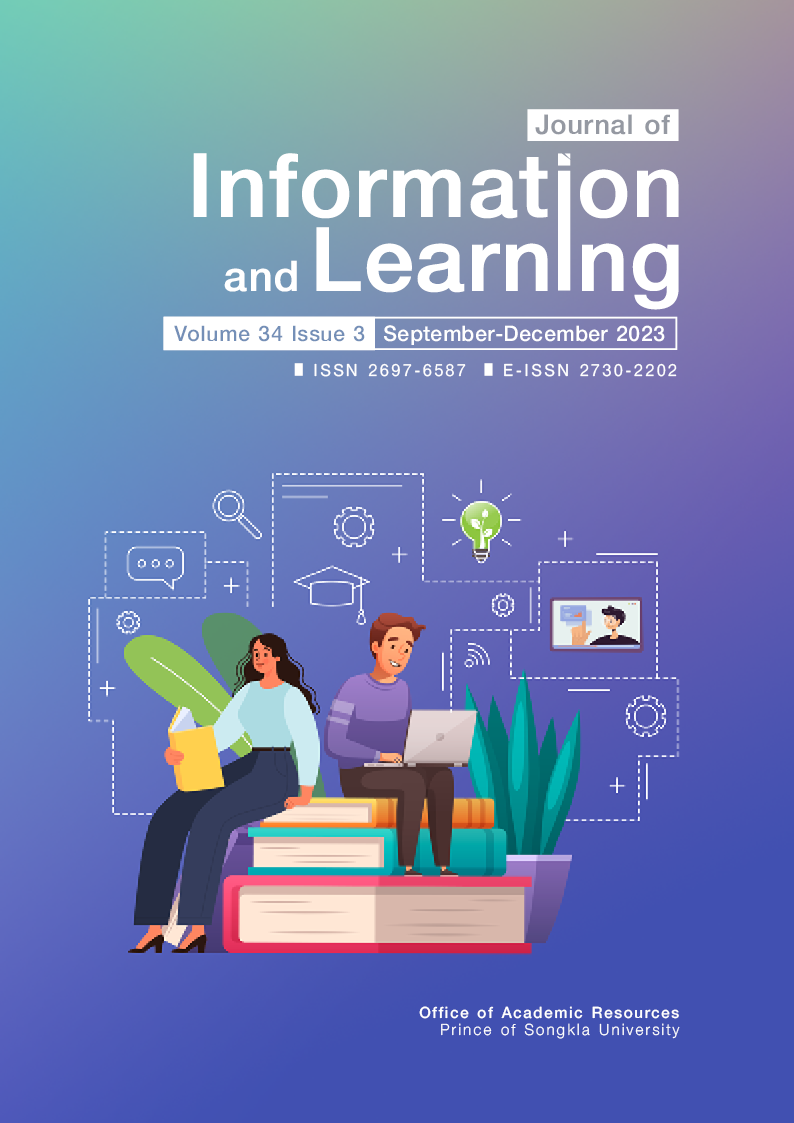Cyberbullying Behavior and Coping Strategies of Youths in Yala Province
Main Article Content
Abstract
The objectives of this research were 1) to investigate online exposure behavior, 2) to examine cyberbullying behavior, 3) to study coping strategies with cyberbullying of youths in Yala Province, 4) to examine the relationship between online exposure behavior, cyberbullying behavior and coping strategies with cyberbullying, and 5) to develop video clip to cope with cyberbullying. This study was survey research involving 362 youths in Yala Province selected through a random sampling technique. The research instruments were a questionnaire and an assessment form of video clip efficiency. The results showed that online exposure behavior of youths in Yala Province was at a moderate level (M = 3.36, SD = 0.62). Cyberbullying among youths in the province was also at a moderate level (M = 2.77, SD = 1.37) while coping strategies employred by the youths to deal with cyberbullying was at a high level (M = 3.54, SD = 1.15). Besides, the correlation coefficient of online exposure behavior and cyberbullying behavior was .329 while that of cyberbullying behavior and coping strategies was .264, that which was in the same direction. Moreover, the results of the video clip development showed that the broadcast video clip on coping strategies for cyberbullying was at the highest efficiency level (M = 4.75, SD = 0.36).
Article Details

This work is licensed under a Creative Commons Attribution-NonCommercial-NoDerivatives 4.0 International License.
The Journal of Information and Learning is operated by the Office of Academic Resources, Prince of Songkla University. All articles published in the journal are protected by Thailand copyright law. This copyright covers the exclusive rights to share, reproduce and distribute the article, including in electronic forms, reprints, translations, photographic reproductions, or similar. Authors own copyrights in the works they have created as well as the Office of Academic Resources. The Journal reserves the right to edit the language of papers accepted for publication for clarity and correctness, as well as to make formal changes to ensure compliance with the journal's guidelines. All authors must take public responsibility for the content of their paper.
References
Aldoobie, N. (2015). ADDIE model. American International Journal of Contemporary Research, 5(6), 68-72. http://www.aijcrnet.com/journals/Vol_5_No_6_December_2015/10.pdf
The Bureau of Registration Administration. (2020). Sathiti prachākō̜n thāngkān thabīan rātsadō̜n [Civil registration and demographic information]. The Bureau of Registration Administration. https://stat.bora.dopa.go.th/stat/statnew/statMONTH/statmonth/#/mainpage
Department of Mental Health. (2019). Klanklǣng bǣp nai pen Cyberbullying? [What type of bullying is Cyberbullying?]. Department of Mental Health. https://www.dmh.go.th/news-dmh/view.asp?id=30035
Electronic Transactions Development Agency. (2019). Cyberbullying: RarānǭnalaiRāyalā nawio [Cyberbullying: Online bullying, millions of views]. Electronic Transactions Development Agency. https://www.etda.or.th/th/Knowledge-Sharing/Cyberbullying-in-IFBL.aspx
Electronic Transactions Development Agency. (2020, March 30). ETDA phœ̄i pī hoksipsō̜ng khon Thai chai ʻin thēnet [Thailand internet user Behavior in 2019 by ETDA]. Electronic Transactions Development Agency. https://www.etda.or.th/th/NEWS/ETDA-Revealed-Thailand-Internet-User-Behavior-2019.aspx
Office of the Council of State. (2010). Phrarātchabanyat khamphiphāksā sān yaowachon læ khrō̜pkhrūa læ withī phičhāranā khadī yaowachon læ khrō̜pkhrūa [Juvenile and family court and procedure act]. http://web.krisdika.go.th/data/law/law2/%C803/%C803-20-2553-a0001.pdf
Office of the Royal Society. (2019, August 14). Cyber bully [Facebook page]. Facebook. Retrieved December 8, 2022, from. https://www.facebook.com/RatchabanditThai/photos/a.2527569647301115/2527570907300989/?type=3
Parris, L., Varjas, K., Meyers, J., & Cutts, H. (2012). High school students’ perceptions of coping with cyberbullying. Youth & Society, 44(2), 284-306. https://doi.org/10.1177/0044118X11398881
Pratan, T., Petcharat, S., Seamhan, P., Hnuchek, K., & Mardyusoh, S. (2017, June 22). The relation between perception and behavior on online social networking of youth in Five Southern Thai Border Provinces [Conference session]. The 8th National and International Academic Conferences. Hatyai, Thailand.
Samoh, N., Boonmongkon, P., Ojanen, T. T., Samakkeekarom, R., & Guadamuz, T. E. (2014). Youth perceptions on cyberbullying. Journal of Behavioral Science for Development, 6(1), 351-364. https://so02.tci-thaijo.org/index.php/JBSD/article/view/16008/
Sawhin, W. (2001). Sampling techniques and sample size determination. Suddhiparitad Journal, 15(47), 80-87. https://so05.tci-thaijo.org/index.php/DPUSuthiparithatJournal/article/view/246650/
Shirley, S. H., Liang, C., & Angelica, P. Y. Ng. (2017). Comparing cyberbullying perpetration on social media between primary and secondary school students. Computers & Edcation Journal, 109, 74-84. https://doi.org/10.1016/j.compedu.2017.02.004
Sirsaad, B. (2002). Kānwičhai bư̄angton (chabap prapprung) [Preliminary research (revised version)]. Suwiriyasan Printing.
Surat, P., Chanprasert, P., & Supchaisakun, A. (2018). Process of cyber bullying in thai youths: Multiple case studies. Journal of Suvarnabhumi Institute of Technology, 4(2), 61-79. https://so04.tci-thaijo.org/index.php/svittj/article/view/177262
Thai Health Promotion Foundation. (2009). Yaowachon kap santisuk sām čhō̜ chāidǣn tai [Peace youth 3 southern border provinces]. https://www.thaihealth.or.th/เยาวชนกับสันติสุข-3-จ-ชาย/
Tudkuea, T., & Laeheem, K. (2014). Development of indicators of cyberbullying among youths in Songkhla Province. Asian Social Science Journal, 10(14), 74-80. https://doi.org/10.5539/ass.v10n14p74
Tudkuea, T., Laeheem, K., & Sittichai, R. (2019). Guidelines for preventive cyber bullying behaviors among secondary school students in the Three Southern Border Provinces. Journal of Behavioral Science for Development, 11(1), 91-106. https://so02.tci-thaijo.org/index.php/JBSD/article/view/149878
Tudkuea, T., & Sabaiying, M., (2017). Patterns, effects and coping with cyber bullying among students of a college in the Southern Part of Thailand. Journal of Behavioral Science for Development, 9(2), 220-236. https://so02.tci-thaijo.org/index.php/JBSD/article/view/82299
Yamane, T. (1970). Statistic: An introductory analysis (2nd ed). Harper & Row.

